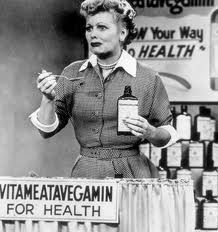Treat Your Fatigue with “Party-girl Drip”

Feeling tired? Energy levels low?
Maybe you drank a bit too much last night?
Why not try one of the latest celebrity health fads? Intravenous vitamin therapy.
Some of its celebrity proponents? Madonna, Simon Cowell and Cindy Crawford. A few weeks ago Rihanna even Tweeted a picture of herself getting an IV drip of what she called the“party-girl drip.”
So, what’s in the drip?
It’s a solution of vitamins and minerals called a Myer’s Cocktail, invented over 30 years ago by Baltimore physician John Myers. It contains magnesium, calcium, various B vitamins (B1, B2, B3, B5, B6, B9, and B12) and vitamin C. The vitamins are typically given in larger doses than are present in vitamin pills. For example, the amount of Vitamin C (25 grams) is almost 300 times the recommended daily dose of 90 milligrams!
Other vitamins or ingredients may be added to the Myers’ Cocktail protocol, “customizing” it to the patient’s diagnosis and overall health as well as the condition being treated.
The procedure typically takes between one and two hours, and can cost $100 to $300 per session. Many devotees attend sessions on a weekly basis.
There are claims that IV vitamin therapy is useful in treating many different condition, including:
- Chronic Fatigue Syndrome with or without Epstein-Barr virus
- Chronic depression
- Acute or chronic muscle spasm
- Fibromyalgia (see below)
- Migraine headaches
- Tension headaches
- Narcotic withdrawal
- Seasonal allergic rhinitis
- Respiratory problems
- Acute or chronic asthma
- Sinusitis
- Bronchitis
- Cardiovascular disease
- Ischemic vascular disease
- Congestive heart failure
- Athletes who need quick recovery for athletic events
- Acute viral illness/colds
- Acute infections
Sound too good to be true? Well, for the most part, it is.
IV vitamin therapy is useful in patients who are nutritionally deprived- those too sick to eat, such as those suffering from cancer. Dr. David L. Katz, director of the Yale University Prevention Research Center and the Integrative Medicine Center at Griffin Hospital, points out some other times when giving IV nutrients can be important:
When older people can’t absorb vitamin B12 due to stomach atrophy, injecting the nutrient is the only way to ensure normal blood levels. Low levels of vitamin D or iron may require repletion by injection. And various conditions resulting in malabsorption, including surgical removal of portions of the intestine, may result in a need for nutrients by injection.
B vitamins are essential for the conversion of the energy of food into a co-enzyme called ATP, which is the form of energy used by cells in your body. Unless you are severely deficient in B vitamins (which is not very common with the American diet) taking more than the recommended amount of B vitamins will not improve your energy level.
Licensed dietician/nutritionist Monica Reinagel puts it this way:
You can’t drive your car if the gas tank is completely empty… You need some gas in the tank to make your engine run. But your car won’t drive any faster on a full tank of gas than it will on a half a tank. And if your gas tank is full and you keep pumping in fuel anyway, it’ll just run out all over your shoes.
That’s much the way it works with B vitamins: If you are completely deficient in one or more B vitamins, your cellular energy production will be impacted—and you’re probably not going to be feeling very well. However, if your B vitamin status is even moderately good, taking extra B vitamins won’t increase your cellular energy production. And if you take in more B vitamins than your body can use or store, the excess will simply spill over—in this case, into your urine.
Is there any scientific evidence that intravenous vitamin therapy or Myer’s Solution can treat any of the above diseases? No, not really. There are anecdotal stories about people with various conditions who said they felt better after an infusion. But stories aren’t scientific evidence. For example, a research study on the effect of IV vitamin therapy on patients with fibromyalgia, paid for the National Center for Complementary and Alternative Medicine (NCCAM), showed no difference between intravenous micronutrient therapy (Myer’s Solution) and a placebo solution of salt water. (Fibromyalgia is a condition of muscle pain and fatigue characterized by “tender points” on the body, specifically the neck, shoulders, back, hips, arms and legs.)
What are the possible side effects or complications of IV vitamin infusions?
Repeated IV infusions can cause hypervitaminosis (an excess of vitamin). High levels of some vitamins can be toxic. Too much Vitamin D can cause damage to the kidneys or bones.
Although high-dose Vitamin C has caused very few side effects in clinical trials, it may be harmful in patients with certain risk factors, such as those with kidney disease, G-6-PD deficiency and hemochromatosis (excess iron).
Too rapid administration of magnesium can cause low blood pressure, which can lead to lightheadedness or even fainting.
Phlebitis, or inflammation of the vein, can develop after an infusion.
What’s the bottom line?
Intravenous micronutrient therapy is no panacea for party girls or boys.




























0 comments